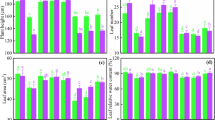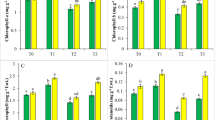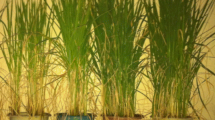Abstract
The aggravation of soil cadmium (Cd) pollution is a serious threat to human food health and safety. To reduce Cd uptake and alleviate Cd toxicity in staple food of wheat, a completely random experiment was performed to investigate the effect of exogenous ascorbic acid (AsA) on Cd toxicity in two wheat varieties (L979 and H27). In this study, the treatments with combinations of Cd (0, 5, and 10 µmol L−1) and AsA (0, 50, and 200 µmol L−1) were applied in a hydroponic system. Toxicity induced by Cd inhibited biomass accumulation; decreased wheat growth, photosynthesis, and chlorophyll content; increased lipid peroxidation; and reduced activity of superoxide dismutase (SOD), but stimulated catalase (CAT) and peroxidase (POD). The addition of AsA significantly improved the growth status by increasing the wheat biomass, chlorophyll content, photosynthetic rate, protein concentrations, and antioxidant enzyme activity. Besides, AsA significantly decreased Cd concentration of shoot and root by 14.1–53.9% and 20.8–59.5% in L979 and 23.7–58.8% and 22.1–58.1% in H27 under Cd5, and 23.7–53.6% and 16.6–57.1% in L979 and 21.5–51.6% and 15.3–54.0% in H27 under Cd10, respectively. Malondialdehyde (MDA) accumulation was decreased remarkably with the addition of AsA by 31.2–32.9% in L979 and 27.1–45.2% in H27 under Cd10, respectively. Overall, exogenous application of AsA alleviated the Cd toxicity in wheat plants by improving the wheat growth, soluble protein content, photosynthesis, and antioxidant defense systems, and decreasing MDA accumulation.



Similar content being viewed by others
Availability of data and materials
The datasets of this study are available from the corresponding author on reasonable request.
References
Al-Hakimi AM, Hamada AM (2011) Ascorbic acid, thiamine or salicylic acid induced changes in some physiological parameters in wheat grown under copper stress. Plant Protect Sci 47: 92–108. https://doi.org/10.17221/20/2010-PPS
Aebi H (1984) Catalase in vitro. Method Enzymol 105:121–126. https://doi.org/10.1016/S0076-6879(84)05016-3
Ahmad P, Abd Allah EF, Hashem A, Sarwat M, Gucel S (2016) Exogenous application of selenium mitigates cadmium toxicity in Brassica juncea L. (czern & cross) by up-regulating antioxidative system and secondary metabolites. J Plant Growth Regul 35:936–950. https://doi.org/10.1007/s00344-016-9592-3
Ahmad P, Ahanger MA, Alyemeni MN, Wijaya L, Alam P (2017) Exogenous application of nitric oxide modulates osmolyte metabolism, antioxidants, enzymes of ascorbate-glutathione cycle and promotes growth under cadmium stress in tomato. Protoplasma 255:1–15. https://doi.org/10.1007/s00709-017-1132-x
Akram NA, Shafiq F, Ashraf M (2017) Ascorbic acid-a potential oxidant scavenger and its role in plant development and abiotic stress tolerance. Front Plant Sci 8:613. https://doi.org/10.3389/fpls.2017.00613
Alamri SA, Siddiqui MH, Al-Khaishany MYY, Khan MN, Ali HM, Alaraidh I, Alsahli AA, Al-Rabiah H, Mateen M (2018) Ascorbic acid improves the tolerance of wheat plants to lead toxicity. J Plant Interact 13:409–419. https://doi.org/10.1080/17429145.2018.1491067
Alayafi AAM (2020) Exogenous ascorbic acid induces systemic heat stress tolerance in tomato seedlings: transcriptional regulation mechanism. Environ Sci Pollut Res 27:19186–19199. https://doi.org/10.1007/s11356-019-06195-7
Apel K, Hirt H (2004) Reactive oxygen species: metabolism, oxidative stress, and signal transduction. Annu Rev Plant Biol 55:373–399. https://doi.org/10.1146/annurev.arplant.55.031903.141701
Aziz A, Akram NA, Ashraf M (2018) Influence of natural and synthetic vitamin C (ascorbic acid) on primary and secondary metabolites and associated metabolism in quinoa (Chenopodium quinoa Willd.) plants under water deficit regimes. Plant Physiol Biochem 123:192–203. https://doi.org/10.1016/j.plaphy.2017.12.004
Naeem A, Saifullah Z-u-R, Akhtar T, Zia MH, Aslam M (2018) Silicon nutrition lowers cadmium content of wheat cultivars by regulating transpiration rate and activity of antioxidant enzymes. Environ Pollut 242:126–135. https://doi.org/10.1016/j.envpol.2018.06.069
Athar HUR, Khan A, Ashraf M (2008) Exogenously applied ascorbic acid alleviates salt-induced oxidative stress in wheat. Environ Exp Bot 63:224–231. https://doi.org/10.1016/j.envexpbot.2007.10.018
Beauchamp C, Fridovich I (1971) Superoxide dismutase: improved assays and an assay applicable to acrylamide gels. Anal Biochem 44:276–287. https://doi.org/10.1016/0003-2697(71)90370-8
Bradford MM (1976) A rapid and sensitive method for the quantitation of microgram quantities of protein utilizing the principle of protein-dye binding. Anal Biochem 72:248–254. https://doi.org/10.1016/0003-2697(76)90527-3
Castillo FJ, Penel C, Greppin H (1984) Peroxidase release induced by ozone in sedum album leaves: involvement of Ca2+. Plant Physiol 74:846–851. https://doi.org/10.1104/pp.74.4.846
Chao YY, Kao CH (2010) Heat shock-induced ascorbic acid accumulation in leaves increases cadmium tolerance of rice (Oryza sativa L.) seedlings. Plant Soil 336:39–48. https://doi.org/10.1007/s11104-010-0438-7
Chaparzadeh N, Ghodrati-Chagharlou M (2013) Alleviation of adverse effects of copper on Allium cepa L. by exogenous ascorbic acid application. J Plant Physiol Breed 3:1–12
Chmielowska-Bak J, Gzyl J, Rucinska-Sobkowiak R, Arasimowicz-Jelonek M, Deckert J (2014) The new insights into cadmium sensing. Front Plant Sci 5:13. https://doi.org/10.3389/fpls.2014.00245
Choppala G, Saifullah BN, Bibi S, Iqbal M, Rengel Z, Kunhikrishnan A, Ashwath N, Ok YS (2014) Cellular mechanisms in higher plants governing tolerance to cadmium toxicity. Crit Rev Plant Sci 33:374–391. https://doi.org/10.1080/07352689.2014.903747
Clemens S, Aarts MGM, Thomine S, Verbruggen N (2013) Plant science: the key to preventing slow cadmium poisoning. Trends Plant Sci 18:92–99. https://doi.org/10.1016/j.tplants.2012.08.003
Gallego SM, Pena LB, Barcia RA, Azpilicueta CE, Lannone MF, Rosales EP, Zawoznik MS, Groppa MD, Benavides MP (2012) Unravelling cadmium toxicity and tolerance in plants: insight into regulatory mechanisms. Environ Exp Bot 83:33–46. https://doi.org/10.1016/j.envexpbot.2012.04.006
Gill SS, Tuteja N (2010) Reactive oxygen species and antioxidant machinery in abiotic stress tolerance in crop plants. Plant Physiol Biochem 48:909–930. https://doi.org/10.1016/j.plaphy.2010.08.016
Greger M, Lofstedt M (2004) Comparison of uptake and distribution of cadmium in different cultivars of bread and durum wheat. Crop Sci 44:501–507. https://doi.org/10.2135/cropsci2004.5010
Hancock RD, Viola R (2005) Biosynthesis and catabolism of L-ascorbic acid in plants. Crit Rev Plant Sci 24:167–188. https://doi.org/10.1080/07352680591002165
He SY, Yang XE, He ZL, Baligar VC (2017) Morphological and physiological responses of plants to cadmium toxicity: a review. Pedosphere 27:421–438. https://doi.org/10.1016/S1002-0160(17)60339-4
Jia HL, Wang XH, Wei T, Wang M, Liu X, Hua L, Ren XH, Guo JK, Li JS (2021) Exogenous salicylic acid regulates cell wall polysaccharides synthesis and pectin methylation to reduce Cd accumulation of tomato. Ecotoxicol Environ Saf 207:111550. https://doi.org/10.1016/j.ecoenv.2020.111550
Jafarnejadi AR, Homaee M, Sayyad G, Bybordi M (2011) Large scale spatial variability of accumulated cadmium in the wheat farm grains. Soil Sediment Contam 20:98–113. https://doi.org/10.1080/15320383.2011.528472
Jin QJ, Zhu KK, Xie YJ, Shen WB (2013) Heme oxygenase-1 is involved in ascorbic acid-induced alleviation of cadmium toxicity in root tissues of Medicago sativa. Plant Soil 366:605–616. https://doi.org/10.1007/s11104-012-1451-9
Kaya C, Ashraf M, Alyemeni MN, Ahmad P (2019) Responses of nitric oxide and hydrogen sulfide in regulating oxidative defence system in wheat plants grown under cadmium stress. Physiol Plant 168:345–360. https://doi.org/10.1111/ppl.13012
Khazaei Z, Estaji A (2020) Effect of foliar application of ascorbic acid on sweet pepper (Capsicum annuum) plants under drought stress. Acta Physiol Plant 42:118. https://doi.org/10.1007/s11738-020-03106-z
Kovacik J, Rotkova G, Bujdos M, Babula P, Peterkova V, Matus P (2017) Ascorbic acid protects Coccomyxa subellipsoidea against metal toxicity through modulation of ROS/NO balance and metal uptake. J Hazard Mater 339:200–207. https://doi.org/10.1016/j.jhazmat.2017.06.035
Kumar S, Kaur R, Kaur N, Bhandhari K, Kaushal N, Gupta K, Bains TS, Nayyar H (2011) Heat-stress induced inhibition in growth and chlorosis in mungbean (Phaseolus aureus Roxb.) is partly mitigated by ascorbic acid application and is related to reduction in oxidative stress. Acta Physiol Plant 33:2091–2101. https://doi.org/10.1007/s11738-011-0748-2
Leff B, Ramankutty N, Foley JA (2004) Geographic distribution of major crops across the world. Glob Biogeochem Cycle 18:GB1009. https://doi.org/10.1029/2003GB002108
Li GZ, Chen SJ, Li NY, Wang YY, Kang GZ (2021) Exogenous glutathione alleviates cadmium toxicity in wheat by influencing the absorption and translocation of cadmium. Bull Environ Contam Toxicol 107:320–326. https://doi.org/10.1007/s00128-021-03283-8
Li YL, Liu YF, Zhang JG (2010) Advances in the research on the AsA-GSH cycle in horticultural crops. Front Agric China 4:84–90. https://doi.org/10.1007/s11703-009-0089-8
Liang YC, Zhu J, Li ZJ, Chu GX, Ding YF, Zhang J, Sun WC (2008) Role of silicon in enhancing resistance to freezing stress in two contrasting winter wheat cultivars. Environ Exp Bot 64:286–294. https://doi.org/10.1016/j.envexpbot.2008.06.005
Liu XL, Zhang SZ, Shan XQ, Christie P (2007) Combined toxicity of cadmium and arsenate to wheat seedlings and plant uptake and antioxidative enzyme responses to cadmium and arsenate co-contamination. Ecotoxicol Environ Saf 68:305–313. https://doi.org/10.1016/j.ecoenv.2006.11.001
Loix C, Huybrechts M, Vangronsveld J, Gielen M, Keunen E, Cuypers A (2018) Reciprocal interactions between cadmium-induced cell wall responses and oxidative stress in plants. Front Plant Sci 8:1867. https://doi.org/10.3389/fpls.2017.01867
Malik S, Ashraf M (2012) Exogenous application of ascorbic acid stimulates growth and photosynthesis of wheat (Triticum aestivum L.) under drought. Soil Environ 31:72–77
Mittler R (2017) ROS are good. Trends Plant Sci 22:11–19. https://doi.org/10.1016/j.tplants.2016.08.002
Moghadam HRT (2016) Application of super absorbent polymer and ascorbic acid to mitigate deleterious effects of cadmium in wheat. Pesqui Agropecu Trop 46:9–18. https://doi.org/10.1590/1983-40632016v4638946
Munne-Bosch S, Alegre L (2002) Interplay between ascorbic acid and lipophilic antioxidant defences in chloroplasts of water-stressed Arabidopsis plants. FEBS Lett 524:145–148. https://doi.org/10.1016/S0014-5793(02)03041-7
Naz S, Anjum MA, Ejaz S, Ali S, Saddiq B, Sardar H, Haider STA (2021) Sewage wastewater reclamation with sand column filter and reduction of heavy metal accumulation in tomato and okra. Environ Sci Pollut Res 28:45962–45970. https://doi.org/10.1007/s11356-021-13976-6
Panda P, Nath S, Chanu TT, Sharma GD, Panda SK (2011) Cadmium stress-induced oxidative stress and role of nitric oxide in rice (Oryza sativa L.). Acta Physiol Plant 33:1737–1747. https://doi.org/10.1007/s11738-011-0710-3
Parrotta L, Guerriero G, Sergeant K, Cal G, Hausman JF (2015) Target or barrier? The cell wall of early- and later-diverging plants vs cadmium toxicity: differences in the response mechanisms. Front Plant Sci 6:133. https://doi.org/10.3389/fpls.2015.00133
Qin SY, Liu HE, Nie ZJ, Rengel Z, Gao W, Li C, Zhao P (2020) Toxicity of cadmium and its competition with mineral nutrients for uptake by plants: a review. Pedosphere 30:168–180. https://doi.org/10.1016/S1002-0160(20)60002-9
Reczek CR, Chandel NS (2015) ROS-dependent signal transduction. Curr Opin Cell Biol 33:8–13. https://doi.org/10.1016/j.ceb.2014.09.010
Rizwan M, Ali S, Abbas T, Zia-ur-Rehman M, Hannan F, Keller C, Al-Wabel MI, Ok YS (2016a) Cadmium minimization in wheat: a critical review. Ecotoxicol Environ Saf 130:43–53. https://doi.org/10.1016/j.ecoenv.2016.04.001
Rizwan M, Ali S, Adrees M, Rizvi H, Zia-ur-Rehman M, Hannan F, Qayyum MF, Hafeez F, Ok YS (2016b) Cadmium stress in rice: toxic effects, tolerance mechanisms, and management: a critical review. Environ Sci Pollut Res 23:17859–17879. https://doi.org/10.1007/s11356-016-6436-4
Sandalio LM, Dalurzo HC, Gomez M, Romero-Puertas MC, del Rio LA (2001) Cadmium-induced changes in the growth and oxidative metabolism of pea plants. J Exp Bot 52:2115–2126. https://doi.org/10.1093/jexbot/52.364.2115
Semida WM, Rady MM, Abd El-Mageed TA, Howladar SM, Abdelhamid MT (2015) Alleviation of cadmium toxicity in common bean (Phaseolus vulgaris L.) plants by the exogenous application of salicylic acid. J Hortic Sci Biotechnol 90:83–91. https://doi.org/10.1080/14620316.2015.11513157
Shalata A, Neumann PM (2001) Exogenous ascorbic acid (vitamin C) increases resistance to salt stress and reduces lipid peroxidation. J Exp Bot 364:2207–2211. https://doi.org/10.1093/jexbot/52.364.2207
Shi GR, Cai QS, Liu CF, Wu L (2010) Silicon alleviates cadmium toxicity in peanut plants in relation to cadmium distribution and stimulation of antioxidative enzymes. Plant Growth Regul 61:45–52. https://doi.org/10.1007/s10725-010-9447-z
Shi ZY, Yang SQ, Han D, Zhou Z, Li XZ, Liu Y, Zhang B (2018) Silicon alleviates cadmium toxicity in wheat seedlings (Triticum aestivum L.) by reducing cadmium ion uptake and enhancing antioxidative capacity. Environ Sci Pollut Res 25:7638–7646. https://doi.org/10.1007/s11356-017-1077-9
Siddiqui S, Meghvansi MK, Wani MA, Jabee F (2009) Evaluating cadmium toxicity in the root meristem of Pisum sativum L. Acta Physiol Plant 31:531–536. https://doi.org/10.1007/s11738-008-0262-3
Siddiqui MH, Al-Whaibi MH, Sakran AM, Basalah MO, Ali HM (2012) Effect of calcium and potassium on antioxidant system of vicia faba L. under cadmium stress. Int J Mol Sci 13:6604–6619. https://doi.org/10.3390/ijms13066604
Singh S, Singh VP, Prasad SM, Sharma S, Ramawat N, Dubey NK, Tripathi DK, Chauhan DK (2019) Interactive effect of silicon (Si) and salicylic acid (SA) in maize seedlings and their mechanisms of cadmium (Cd) toxicity alleviation. J Plant Growth Regul 38:1587–1597. https://doi.org/10.1007/s00344-019-09958-1
Smirnoff N (2000) Ascorbate biosynthesis and function in photoprotection. Philos Trans R Soc Lond B Biol 355:1455–1464. https://doi.org/10.1098/rstb.2000.0706
Song A, Li ZJ, Zhang J, Xue GF, Fan FL, Liang YC (2009) Silicon-enhanced resistance to cadmium toxicity in Brassica chinensis L. is attributed to Si-suppressed cadmium uptake and transport and Si-enhanced antioxidant defense capacity. J Hazard Mater 172:74–83. https://doi.org/10.1016/j.jhazmat.2009.06.143
Tai ZL, Yin XQ, Fang ZG, Shi GL, Lou LQ, Cai QS (2017) Exogenous GR24 alleviates cadmium toxicity by reducing cadmium uptake in switchgrass (Panicum virgatum) seedlings. Int J Environ Res Public Health 14:852. https://doi.org/10.3390/ijerph14080852
Ullah HA, Javed F, Wahid A, Sadia B (2016) Alleviating effect of exogenous application of ascorbic acid on growth and mineral nutrients in cadmium stressed barley (Hordeum vulgare) seedlings. Int J Agric Biol 18: 73–79. https://doi.org/10.17957/IJAB/15.0064
Ullah I, Waqas M, Khan MA, Lee IJ, Kim WC (2017) Exogenous ascorbic acid mitigates flood stress damages of Vigna angularis. Appl Biol Chem 60:603–614. https://doi.org/10.1007/s13765-017-0316-6
Vaculik M, Pavlovic A, Lux A (2015) Silicon alleviates cadmium toxicity by enhanced photosynthetic rate and modified bundle sheath’s cell chloroplasts ultrastructure in maize. Ecotoxicol Environ Saf 120:66–73. https://doi.org/10.1016/j.ecoenv.2015.05.026
Velikova V, Yordanov I, Edreva A (2000) Oxidative stress and some antioxidant systems in acid rain-treated bean plants. Plant Sci 151:59–66. https://doi.org/10.1016/S0168-94529900197-1
Waalkes MP (2000) Cadmium carcinogenesis in review. J Inorg Biochem 79:241–244. https://doi.org/10.1016/S0162-0134(00)00009-X
Wang ZF, Li Q, Wu WG, Guo J, Yang YL (2017) Cadmium stress tolerance in wheat seedlings induced by ascorbic acid was mediated by NO signaling pathways. Ecotoxicol Environ Saf 135:75–81. https://doi.org/10.1016/j.ecoenv.2016.09.013
Wang X, Wu L, Xie JJ, Li TH, Cai J, Zhou Q, Dai TB, Jiang D (2018a) Herbicide isoproturon aggravates the damage of low temperature stress and exogenous ascorbic acid alleviates the combined stress in wheat seedlings. Plant Growth Regul 84:293–301. https://doi.org/10.1007/s10725-017-0340-x
Wang P, Yang B, Wan HB, Fang XL, Yang CY (2018b) The differences of cell wall in roots between two contrasting soybean cultivars exposed to cadmium at young seedlings. Environ Sci Pollut Res 25:29705–29714. https://doi.org/10.1007/s11356-018-2956-4
Wang L, Fan J, Wei C, Li GZ, Zhang JJ, Jiao QJ, Cheng G, Sun LZ, Liu HT (2021) Mitigative effect of exogenous ascorbic acid on the growth of copper-stressed chicory (Cichorium intybus) seedlings. Acta Pratacul Sini 30: 150–159. https://doi.org/10.11686/cyxb2020411
Xie XJ, Zhou QX, Lin DS, Guo JM, Bao YY (2011) Toxic effect of tetracycline exposure on growth, antioxidative and genetic indices of wheat (Triticum aestivum L.). Environ Sci Pollut Res 18:566–575. https://doi.org/10.1007/s11356-010-0398-8z
Xu B, Shi G, Xu Q, Wang X, Zhao J, Hu J (2006) Protective effects of exogenous ascorbic acid on antioxidant system in Hydrilla verticillata under Cd2+. China J Appl Ecol 17:1768–1770
Yan L, Li Y, Ma YH, He LF, Li SW (2021) Abscisic acid modulates differential physiological and biochemical responses of roots, stems, and leaves in mung bean seedlings to cadmium stress. Environ Sci Pollut Res 28:6030–6043. https://doi.org/10.1007/s11356-020-10843-8
Yuan HM, Liu WC, Jin Y, Lu YT (2013) Role of ROS and auxin in plant response to metal-mediated stress. Plant Signal Behav 8:e24671. https://doi.org/10.4161/psb.24671
Zeshan A, Abdullah M, Adil MF, Wei DM, Noman M, Ahmed T, Sehar S, Ouyang YN, Shami IH (2021) Improvement of morpho-physiological, ultrastructural and nutritional profiles in wheat seedlings through astaxanthin nanoparticles alleviating the cadmium toxicity. J Hazard Mater 126511. https://doi.org/10.1016/j.jhazmat.2021.126511
Zhang KP, Wang GY, Bao MC, Wang LC, Xie XY (2019) Exogenous application of ascorbic acid mitigates cadmium toxicity and uptake in Maize (Zea mays L.). Environ Sci Pollut Res 26:19261–19271. https://doi.org/10.1007/s11356-019-05265-0
Zhou M, Zheng SG, Liu R, Lu J, Lu L, Zhang CH, Liu ZH, Luo CP, Zhang L, Wu Y (2019a) Comparative analysis of root transcriptome profiles between low- and high-cadmium-accumulating genotypes of wheat in response to cadmium stress. Funct Integr Genomic 19:281–294. https://doi.org/10.1007/s10142-018-0646-4
Zhou M, Zheng SG, Liu R, Lu L, Zhang CH, Zhang L, Yant L, Wu Y (2019b) The genome-wide impact of cadmium on microRNA and mRNA expression in contrasting Cd responsive wheat genotypes. BMC Genomics 20:615. https://doi.org/10.1186/s12864-019-5939-z
Zhou Z, Zhang B, Liu HT, Liang XD, Ma WL, Shi ZY, Yang SQ (2019c) Zinc effects on cadmium toxicity in two wheat varieties (Triticum aestivum L.) differing in grain cadmium accumulation. Ecotoxicol Environ Saf 183: 109562. https://doi.org/10.1016/j.ecoenv.2019.109562
Funding
This research was supported by The National Natural Science Foundation of China (31901090, 41907323), Project of Science and Technology Activities for Overseas Scientists in Henan Province (30602340), The special fund for young talents in Henan Agricultural University (30500671, 30500726), Open Project Fund of State Key Laboratory of Crop Biology of Shandong Agricultural University (2018KF05), and National College Student Innovation and Entrepreneurship Training Program (202010466037).
Author information
Authors and Affiliations
Contributions
All authors contributed to the study conception and experimental design. ZZ and CW: data curation and writing the original draft. HL: project administration, supervision, and validation. QJ: investigation and methodology. GL, JZ, and BZ: writing, review, and editing. WJ, DL, and GC: conceptualization, software, and visualization. SY: resources and investigation.
The first authors ZZ and CW contributed equally to this manuscript.
All authors read and approved the final versions.
Corresponding author
Ethics declarations
Ethics approval
Not applicable.
Consent to participate
Not applicable.
Consent for publication
Not applicable.
Competing interests
The authors declare no competing interests.
Additional information
Responsible Editor: Gangrong Shi
Publisher's note
Springer Nature remains neutral with regard to jurisdictional claims in published maps and institutional affiliations.
Zhen Zhou and Chang Wei are the joint first authors; the two authors contributed equally to this manuscript.
Rights and permissions
About this article
Cite this article
Zhou, Z., Wei, C., Liu, H. et al. Exogenous ascorbic acid application alleviates cadmium toxicity in seedlings of two wheat (Triticum aestivum L.) varieties by reducing cadmium uptake and enhancing antioxidative capacity. Environ Sci Pollut Res 29, 21739–21750 (2022). https://doi.org/10.1007/s11356-021-17371-z
Received:
Accepted:
Published:
Issue Date:
DOI: https://doi.org/10.1007/s11356-021-17371-z




